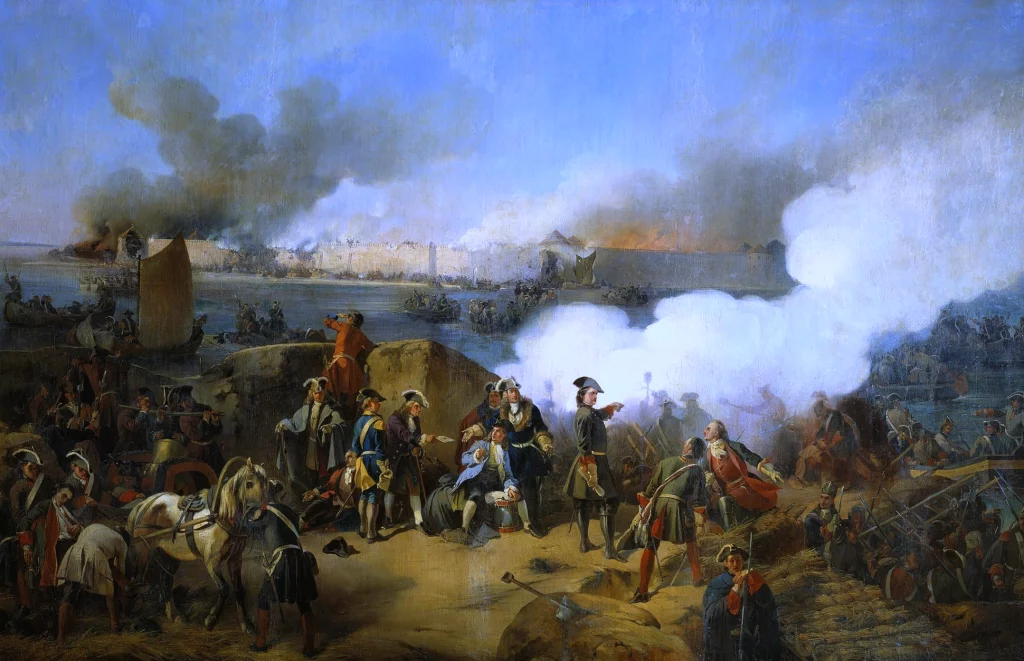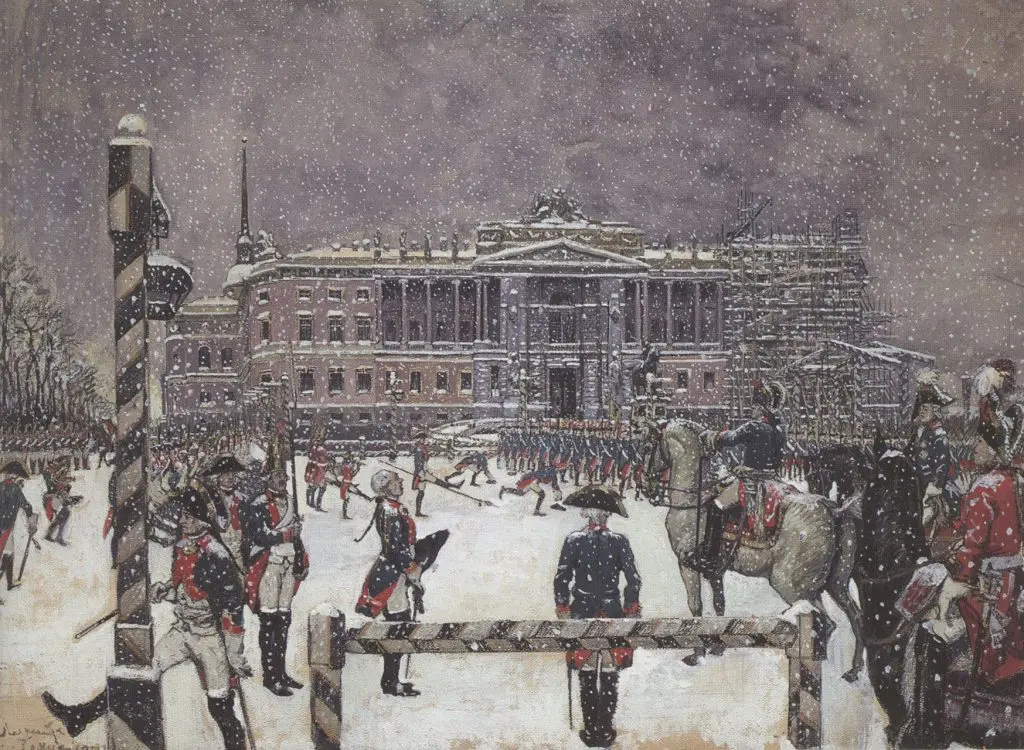According to a popular claim, peasants conscripted into the imperial army were taught the basics using a very unusual technique. We checked whether there is reason to trust this story.
For decades now, there has been a widespread belief that when recruiting illiterate recruits into the regular Russian army, their commanders were faced with a problem: the recruits did not know what right and left were. The solution found helped to overcome the difficulty: straw was tied to the soldier’s right leg, and hay was tied to the left leg, which he could distinguish. In this way, marching and performing simple maneuvers allegedly became possible. In the overwhelming majority of popular sources, this “invention” is associated with Peter I, under whom a regular army appeared in Russia, or at least with one of the officers of that era. History in this form can be found, for example, in public pages "VKontakte", V "LiveJournal" Artemy Lebedev, in collections of interesting facts about Peter I from publishing house AST, "Komsomolskaya Pravda" And RIA Novosti. However, there are other versions - for example, Vladimir Boyko in an article for the Russia Beyond portal attributes the authorship of this “invention” was to commander Alexander Suvorov.
The most famous source that talks about the emergence of such practices in the Russian army is Alexei Tolstoy’s novel “Peter the First.” Like any work of art, it is difficult to consider this text a reliable historical source; this was also noted by Soviet critics. Thus, Vladimir Shcherbina in his article about Tolstoy’s novels wrote: “A living sense of a long-past era with its way of life and psychology could not be given only on the basis of historical documents. Here the artist’s creative imagination and his highly developed patriotic sense of his native country with all its truth of life, its language, legends, songs and fairy tales, which was highly developed since childhood, were reflected in full force.”
However, in the novel "Peter the Great" There is this fragment:
"They caught up with half a company of soldiers in brown, awkward caftans, with bundles of grass and straw tied to their feet - they walked randomly, colliding with baguettes. Sergeant - desperately: "Smyrna!" Peter got out of the monocart, took one soldier by the shoulders, turned another, and felt the clumsy cloth.
- Shit! - he shouted, rolling his eyes at the acne-prone sergeant. — Who put on the caftans?
- Mr. Bombardier, the caftans were issued on a dry rubbish train.
- Take off your clothes. - Peter grabbed the third - a sharp-nosed, skinny soldier. But he seemed to be choked with horror, looking into the round face of the bombardier looming over him, with the stubble of a black mustache. Nearby comrades pulled the gun out of his hands, unfastened the sling, and pulled the caftan off his shoulders. Peter grabbed the caftan, threw it into the monocar and, without adding another word, sat down and drove towards the Menshikov Palace.
The undressed soldier, trembling in all joints, looked fascinated at the one-wheeled car moving away along the grassy road. The sergeant pushed him with his cane:
- Golikov, get out of line, trudge back... Smir-r-rna! (With his mouth open, he threw himself over and yelled at the whole field.) The left leg is hay, the right leg is straw. Remember the science... Step by step - hay - straw, hay — straw…»

Another author who has repeatedly mentioned this “invention” of the Petrine era is Sergei Alekseev, who wrote many historical stories. As with Tolstoy's novel, these texts were not scientific studies, and their author was not an authoritative historian. However, Alekseev received an appropriate education - during the war in a year and a half graduated History Faculty of the Orenburg Pedagogical Institute, but we were unable to find any professional works among its bibliography. In the collection “One Hundred Stories from Russian History” there is a story called "Hay, straw", however, what is happening differs from what Tolstoy described:
"One day Peter was driving past the soldiers' barracks. He looks - the soldiers are lined up, they are learning to walk in formation. A young lieutenant walks next to the soldiers and gives commands. Peter listened: the commands were somehow unusual.
- Hay, straw! - the lieutenant shouts. - Hay, straw!
"What's happened?" - thought Peter. He stopped his horse and took a closer look: there was something tied on the soldiers’ legs. The king saw: there was hay on his left leg, and straw on his right leg.
The officer saw Peter and shouted:
- Attention!
The soldiers froze. The lieutenant ran up to the king and gave a report:
- Mr. Bombardier-Captain, Lieutenant Vyazemsky’s company is learning to walk!
- At ease! - Peter gave the command.
The king liked the lieutenant. Peter wanted to be angry for the “hay, straw,” but now he changed his mind. Asks Lieutenant Vyazemsky:
“Why did you impose all sorts of rubbish on the soldiers’ feet?”
“Not rubbish at all, bombardier-captain,” the lieutenant replies.
- How come - don’t be rubbish! - Peter objects. “You’re a disgrace to the soldier.” You don't know the regulations.
And the lieutenant is all his.
“No way,” he says. “This is to make it easier for soldiers to learn.” The darkness, the bombardier-captain, can’t tell where the left foot is and where the right is. But they don’t confuse hay with straw: they are rustic.
The king marveled at the invention and grinned.
And soon Peter hosted the parade. The last company was the best.
- Who is the commander? - Peter asked the general.
“Lieutenant Vyazemsky,” answered the general.”
Subsequently, this story was reprinted in other Alekseev collections, for example "Glory Bird", "Historical stories" And “A book to read on the history of our homeland from 1670 to 1945”.
Although stories about hay and straw in the Russian army are found in numerous publications on the Internet and works of art, we were unable to find any mention of it in professional historical texts. The only exception that was discovered was a lecture by military historian Boris Kipnis for the Arzamas project, in which the scientist speaks: “But, of course, you need to study military affairs. Without this, everything is useless. Therefore, Peter’s famous “hay - straw” - it is very important that the soldiers distinguish: where is the right (hay) and where is the left (straw) - and know how to turn.” As we see, in Kipnis’s version (if we take his words literally), the authorship of the unusual technique belongs directly to Peter I, and it was supposed to be used for rebuilding, and not for marching. Moreover, in the historian’s presentation, hay and straw correspond to different sides than in most retellings of this plot.
There is evidence that this technique was used in Russia, but not in the army. Musicologist Vyacheslav Shchurov in his book “Genres of Russian Musical Folklore” tells about the songs that accompanied the work of the Volga barge haulers: “In order to force the sleepy ones to keep up, but not to waste time stopping, turning around and finding the culprit, the artel stops singing the song they have already started and begins the well-known refrain in a common chorus: “Hay! Straw! Hay! Straw!” The author refers to the report of ethnographer Pavel Nebolsin on a trip to the mouth of the Volga, which was published in 1852. We were unable to find out whether the “famous refrain” was borrowed from army culture or the barge haulers’ own invention.
In the English-speaking scientific community, the use of hay and straw in the Russian army is a relatively popular topic, but not among historians, but among psychologists. In particular, about such training of illiterate soldiers tells University College London professor Chris McManus in his book “Right Hand, Left Hand. The Origin of Asymmetry in Brains, Bodies, Atoms and Cultures." The researcher refers to his colleague Wilma Fritsch and her 1968 work "Left and Right in Science and Life", and she, in turn, to the German physician Kurt Else. We were unable to find out where this specialist learned about the unusual innovation in the Russian army, but it is noteworthy that in the case of McManus’s book, the statement appears in the text without relying on historical research.
In the context of neurophysiology and other sciences about human thinking, the story about hay and straw is told by a much more popular author in Russia, Sam Keene. This American non-fiction writer published five books, most of which became bestsellers and were translated into Russian. In one of them, “Duel of Neurosurgeons. How the secrets of the brain were discovered and why the death of one king could revolutionize science,” There is such a fragment: “Russian sergeants in the 19th century were so fed up with illiterate peasants who could not distinguish left from right that they tied a bundle of hay to one leg and a bundle of straw to the other, and then commanded “Hay, straw, hay, straw!” to teach them to walk in step.” As you can see, here we are no longer talking about the Petrine era - a unique technique was allegedly invented a century later. Note that among the sources for the chapter in which this statement is given, there are no works written by historians.

Unlike texts in Russian, evidence of hay and straw being used to distinguish between left and right legs is found in English-language historical works. For example, in 1951, Bruce Catton in the book "Mr. Lincoln's Army" reportedthat such technology was used to train illiterate soldiers during the American Civil War in the mid-19th century. Allegedly, the term “straw-foot” even appeared to refer to a recruit. In 1922, Wilbur Fiske Crafts brought a similar story, but about the American War of Independence, which took place almost a century earlier. Evidence of such practices in Europe also dates back to the 19th century, but appears to be more robust: for example, there are memories about how English commanders trained Scottish recruits who did not speak English.
Thus, the story about hay and straw in the Russian army is given in numerous sources, but the vast majority of them have serious questions. In texts in Russian, this plot is presented mainly in literary texts on historical topics, while professional historians (at least in any significant quantity) do not present it in their works. In English, mostly psychologists and physiologists talk about hay and straw on the feet of Russian soldiers, without referring to specialists in history or military affairs. At the same time, several historians talk about the use of such technology in the USA and Great Britain, but we were unable to find evidence that it was borrowed from Russia. Let us repeat that this plot does not have a canonical presentation - depending on the text where it is given, both the historical era and the authorship of the “invention” change.
This is not accurate
- Fact check: 16 most popular legends about Peter I
- A. Tolstoy. Peter the Great
- Did Peter I issue a decree that a subordinate should look dashing and stupid in front of his superiors?
If you find a spelling or grammatical error, please let us know by highlighting the error text and clicking Ctrl+Enter.







